Homemade Buttermilk Bread made easy at home with 6 ingredients! This buttermilk bread recipe creates a soft loaf that has incredible flavor & can even be made in your bread machine.
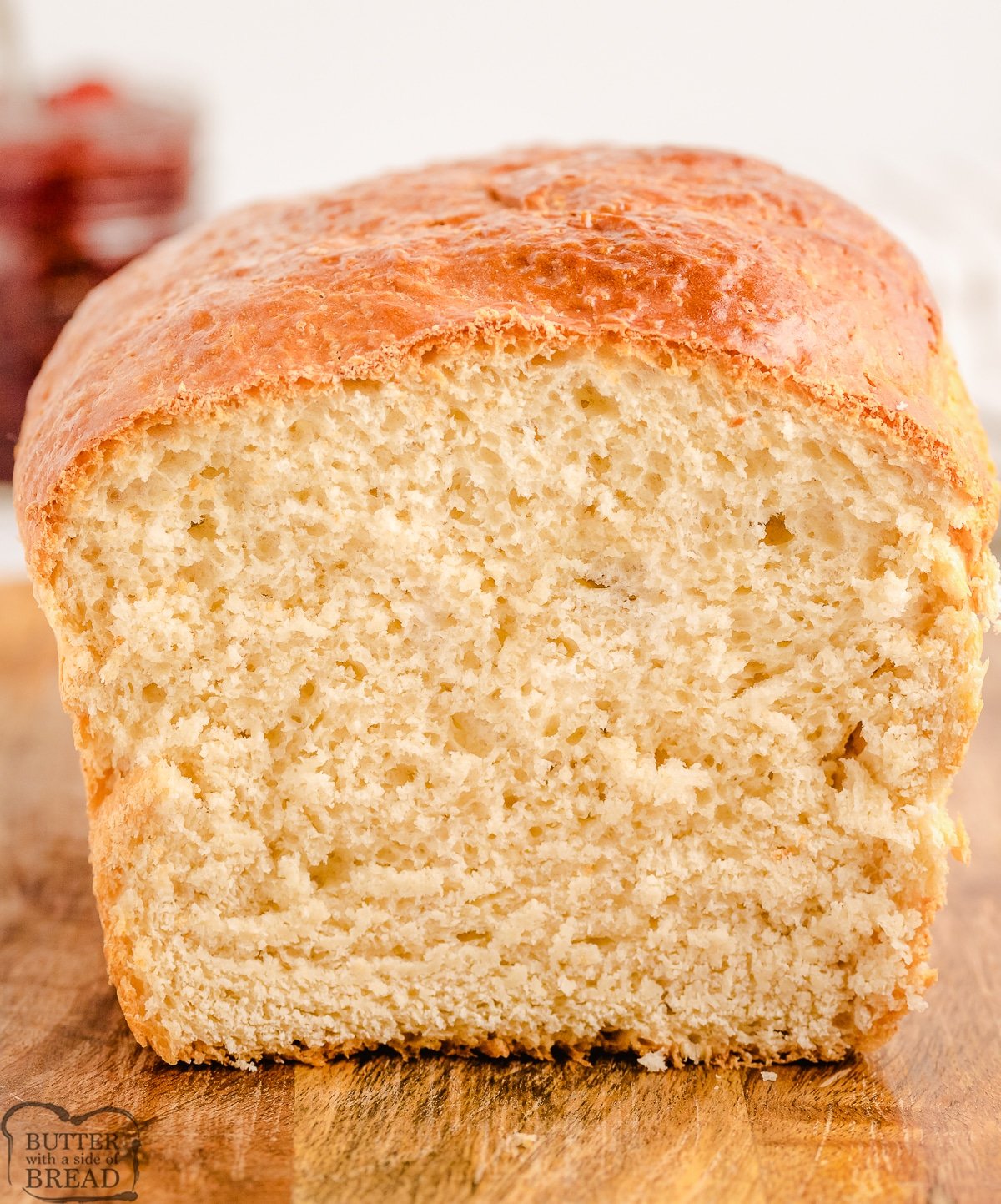
Making this quick bread recipe is so simple, made with just a handful of ingredients that are most likely already in your kitchen and pantry. Buttermilk bread has such a delicate texture and tastes incredible too, give it a try today and see how amazing it is!
If you love Bread as much as we do, find all of our Best Bread Recipes Here!
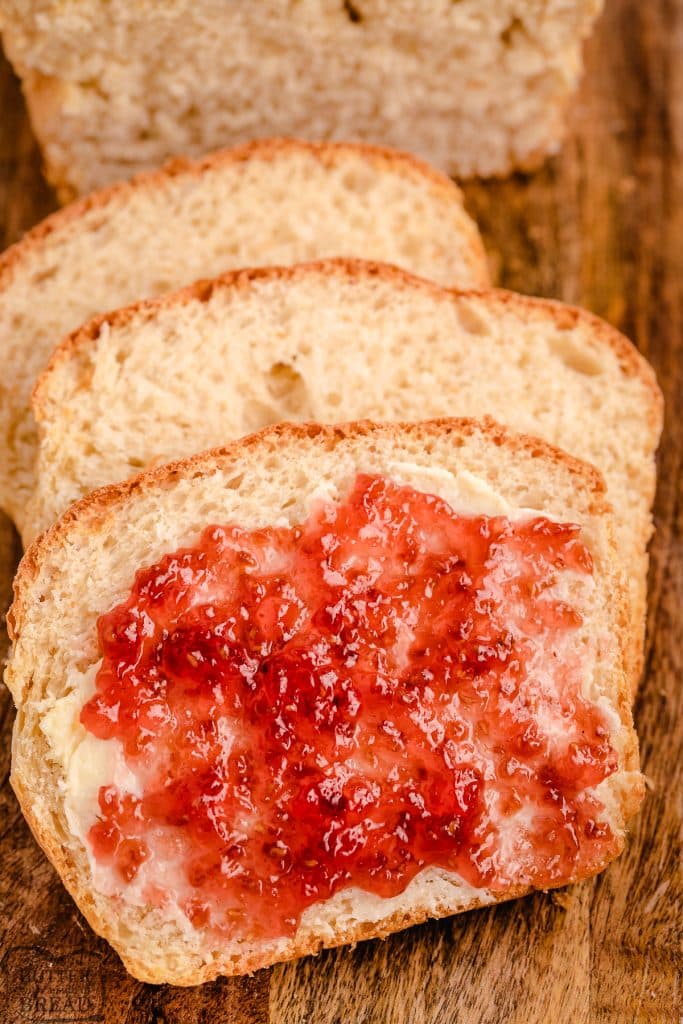
Tips to create the BEST bread every time
If you have never baked homemade bread before, here are a few tips that will help you make the most delicious and soft bread ever.
- Remember to fully knead. The recipe below kneads for 10 minutes and it is worth every minute. Kneading dough helps to develop the flavor and texture of the bread, so don’t skimp on kneading time.
- Weather can affect your ingredients. If you live in a moist climate, chances are you will need at least the recommended amount of flour, maybe even 1/4 cup to 1/2 cup more. Bread dough should be sticky, but still manageable, especially after the first rise. While you are kneading, the dough should come together and pull away from the sides of the bowl, leaving the bowl mostly clean. (I try not to add too much flour because your bread will be more dense.) When you pick the dough up, some will stick to your fingers. After the first rise, it will be easier to handle!
- Kitchen too cool to rise? In the wintertime when my house is cooler than normal, I like to turn the oven on for 2-3 minutes, then turn it off and let the bowl of dough rise in there. The oven traps the heat for a longtime and it is the perfect atmosphere for rising dough.
- After the first rise, don’t overwork the dough. I usually knead and shape my dough in about 1 minute, then it is back in the pan to rest, for the 2nd rise. I like to have the pan rise in the oven for this second rise so that I don’t have to worry about moving risen dough. I just turn the oven on and set the timer to bake!
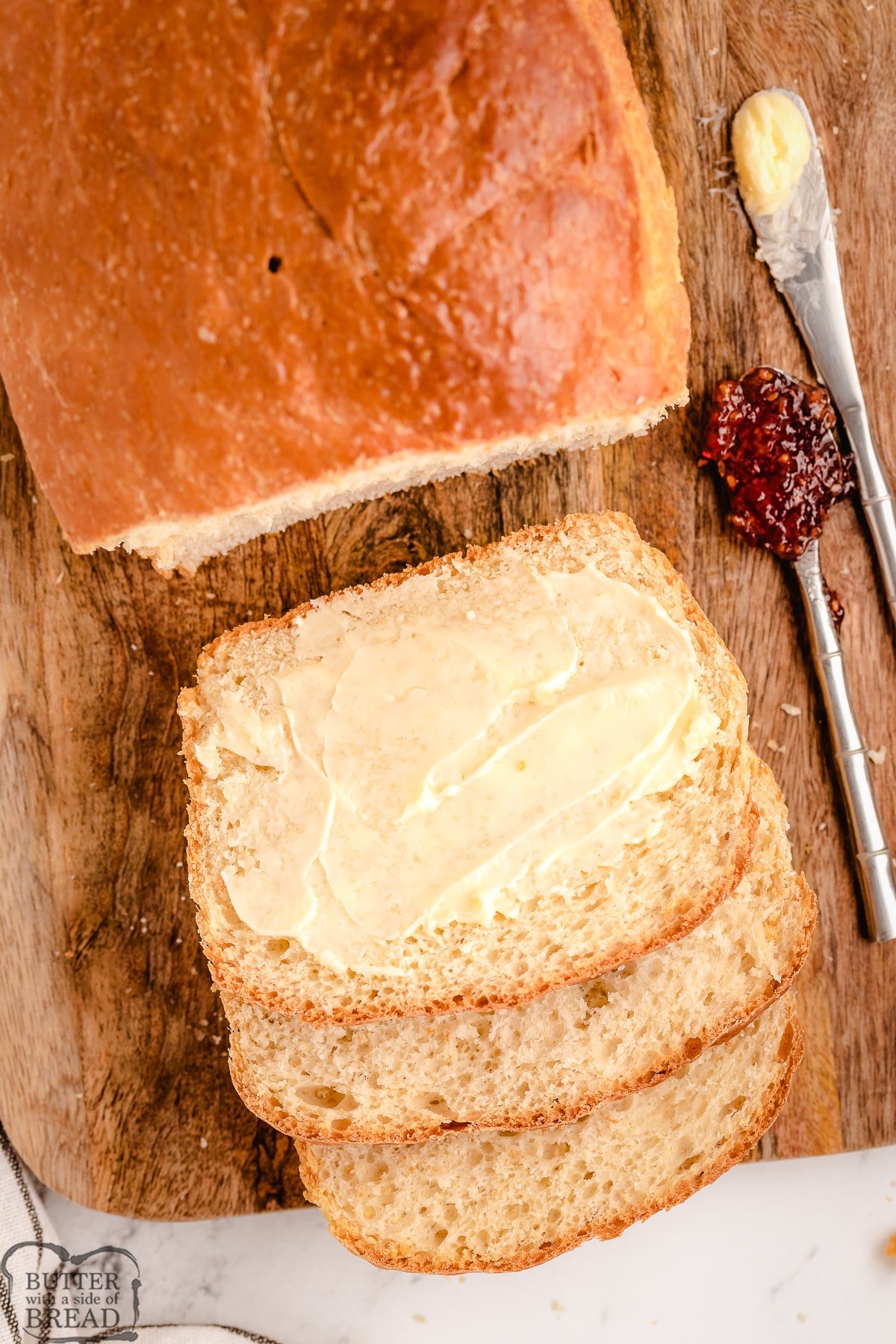
Can I made this Homemade Buttermilk Bread in a Bread Machine?
YES! I have had wonderful results making this Buttermilk Bread in my bread machine. You don’t have to make any ingredient changes either- simple add them to your bread machine pan in the order listed below. I used the “Basic White Bread” setting with a light crust and it turned out beautifully.
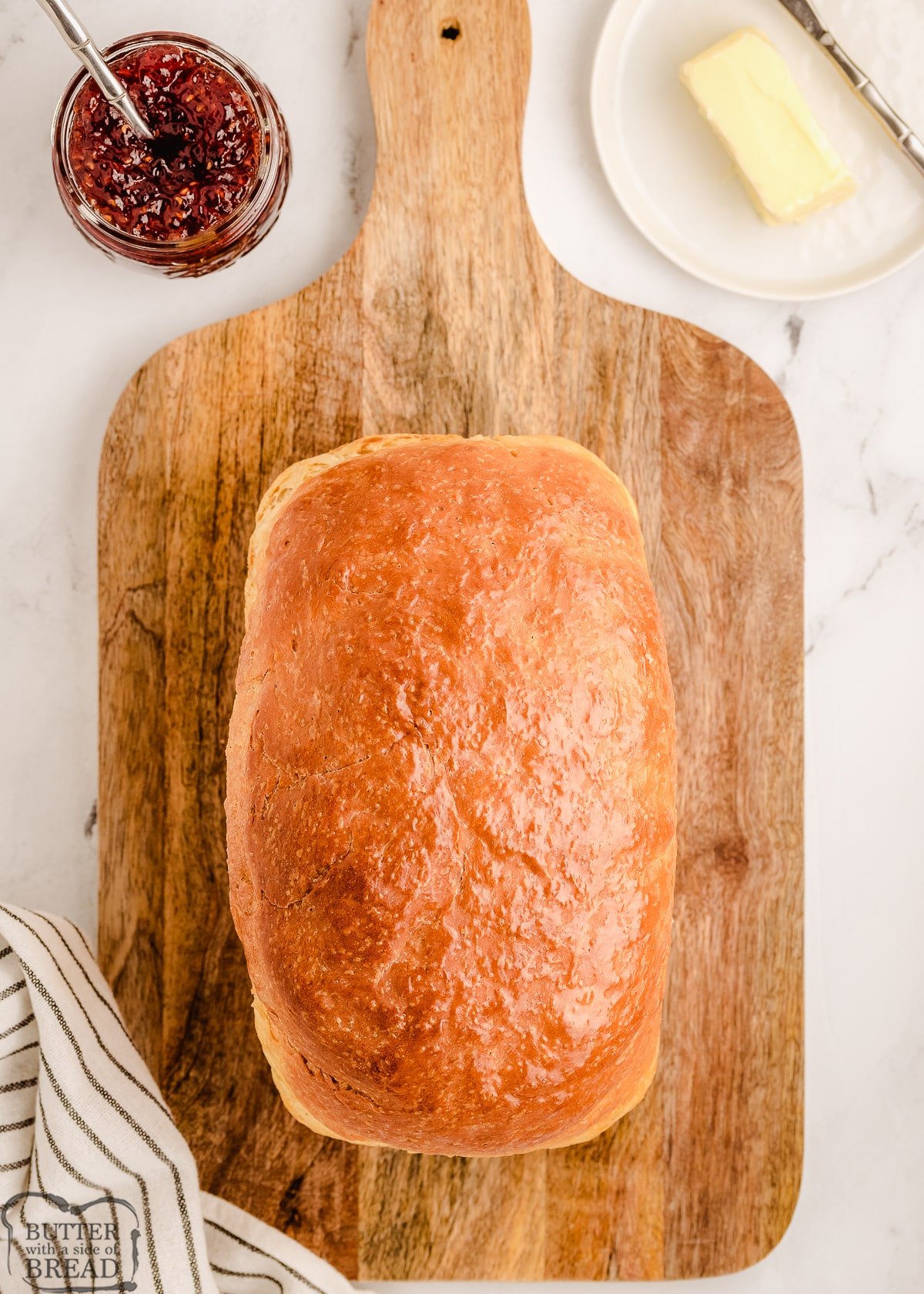
Homemade Buttermilk Bread Ingredients
Buttermilk: You will need 1 ½ cups of buttermilk* to create the most amazing homemade bread.
Butter: Adding in 2 tablespoons of melted butter will make this bread rich in taste.
Sugar: Use 2 tablespoons of sugar to help sweeten this bread up perfectly.
Salt: You will want to add in 1 teaspoon of salt to help balance the flavors in this bread well.
Flour: The base of this recipe is 3 ½ cups of all-purpose or bread flour.
Yeast: To make the bread rise properly, you will need 1 tablespoon of yeast.
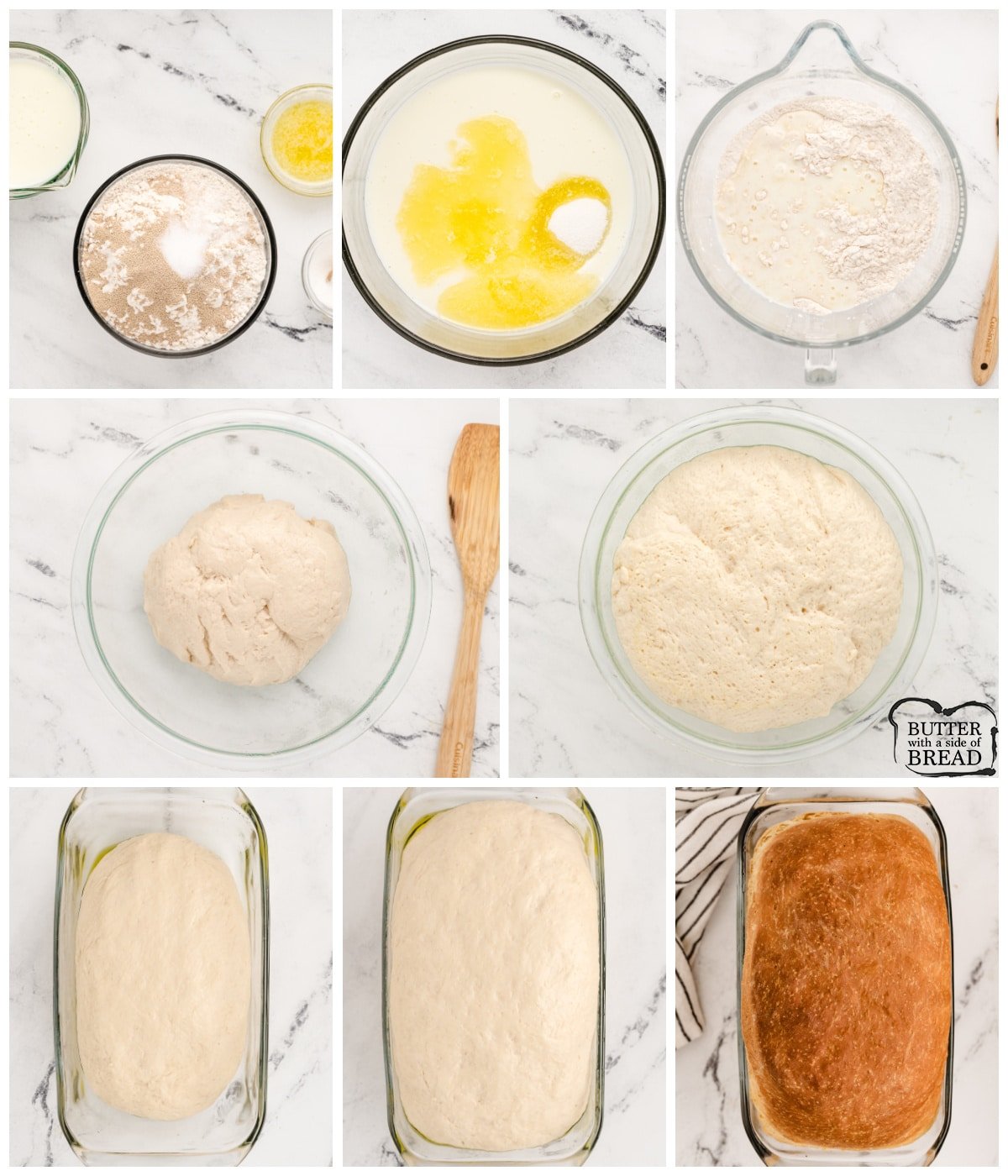
How to make Homemade Buttermilk Bread from scratch
Dough prep
Start by combining the buttermilk, melted butter and sugar in a large mixing bowl. *You can substitute regular milk + lemon juice for buttermilk, but you won’t quite get the full texture and flavor of this bread. So add buttermilk to the grocery list; you’ll love it!
Then, in a separate bowl, combine the salt, flour and yeast. Whisk the dry ingredients together to combine, then add them to the wet buttermilk mixture in the mixing bowl. Mix all ingredients together until well combined (I use a KitchenAid Mixer.)
I like about a quarter sized amount of dough to be sticking on the very bottom. If your dough looks a bit dry, add in another splash of buttermilk. Once you have achieved a good consistency, mix the dough on low for about 6-7 minutes (or knead by hand about 10 minutes). Proper kneading is critical to great textured homemade bread!
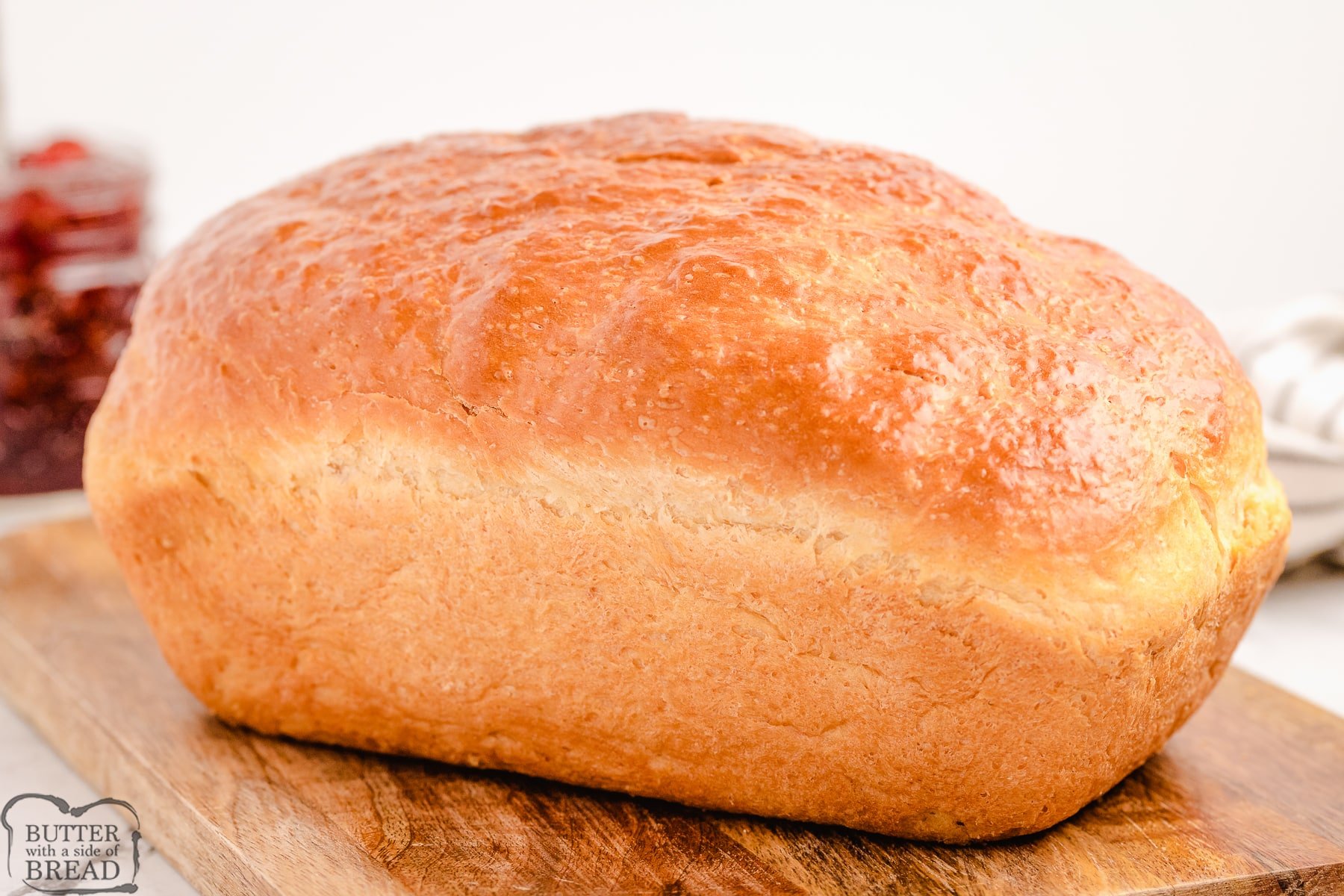
First rise
Once the dough is done kneading, proceed to cover the bowl with a towel and let it rise in a warm place for about 1 hour; until the dough has doubled in size.
Second rise
After the first rise, punch the dough down and knead several times, then shape the dough (I like to roll mine, then tuck the ends under) and place in a greased bread loaf pan. Place the dough back in the warm spot and let it rise for another 30-45 minutes.
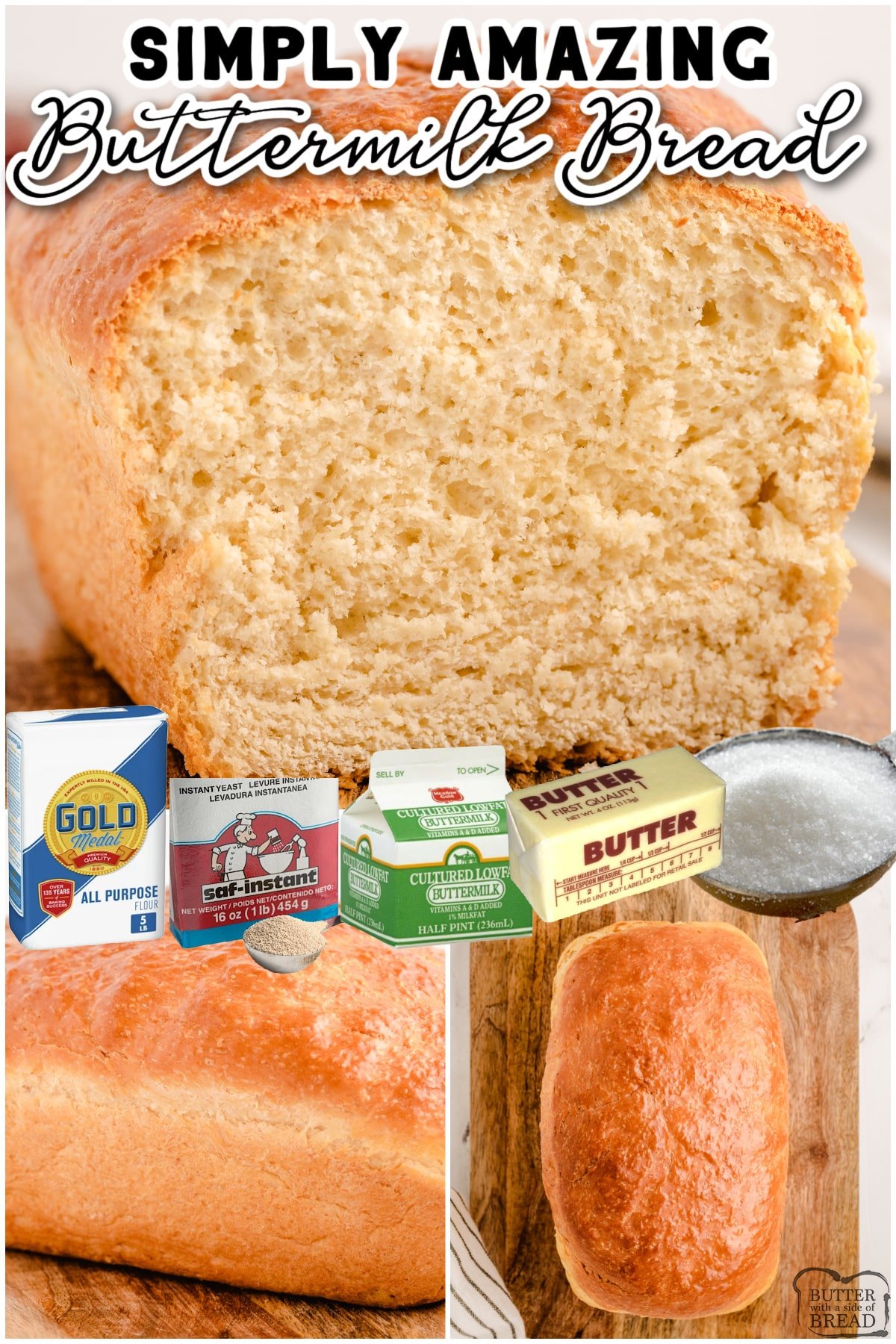
Bake
Get the oven preheating to 350 degrees F. Once the second rise is complete, bake the dough for about 30-35 minutes, until the top is golden brown.
Let the bread cool in the pan for 10-15 minutes after baking is complete, then overturn the pan and turn the loaf out onto a cooling rack or folded towel to finish cooling.
When ready to enjoy, slice, serve and enjoy!
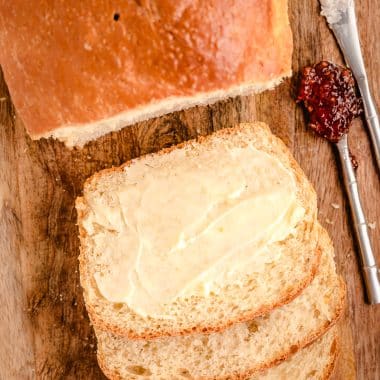
HOMEMADE BUTTERMILK BREAD
Ingredients
- 1 ½ cups buttermilk*
- 2 TBSP melted butter
- 2 TBSP sugar
- 1 tsp salt
- 3 ½ cups all-purpose or bread flour
- 1 TBSP yeast
Instructions
- Dough prep: Start by combining the buttermilk, melted butter and sugar in a large mixing bowl.*
- Then, in a separate bowl, combine the salt, flour and yeast. Whisk the dry ingredients together to combine, then add them to the wet buttermilk mixture in the mixing bowl. Mix all ingredients together until well combined (I use a KitchenAid Mixer.) I like about a quarter sized amount of dough to be sticking on the very bottom.
- If your dough looks a bit dry, add in another splash of buttermilk. Once you have achieved a good consistency, mix the dough on low for about 6-7 minutes (or knead by hand about 10 minutes). Proper kneading is critical to great textured homemade bread!
- First rise: Once the dough is done kneading, proceed to cover the bowl with a towel and let it rise in a warm place for about 1 hour; until the dough has doubled in size.
- Second rise: After the first rise, punch the dough down and knead several times, then shape the dough (I like to roll mine, then tuck the ends under) and place in a greased bread loaf pan. Place the dough back in the warm spot and let it rise for another 30-45 minutes.
- Bake: Get the oven preheating to 350 degrees F. Once the second rise is complete, bake the dough for about 30-35 minutes, until the top is golden brown. Let the bread cool in the pan for 10-15 minutes after baking is complete, then overturn the pan and turn the loaf out onto a cooling rack or folded towel to finish cooling. When ready to enjoy, slice, serve and enjoy!
Video
Notes
Nutrition
📫 Save this recipe! Send it to your email! 📩
I consent to receiving emails from this site.
HOW TO AVOID SUNKEN BREAD
The easiest and best way to avoid sunken bread is to use a cooking thermometer to check the inside of the loaf. Fully cooked bread will register 200°F on a thermometer. My all-time favorite thermometer is the Thermapen. It’s super fast and incredibly durable. Another great cooking thermometer is the ThermoPop which is a more basic version that works just as well!
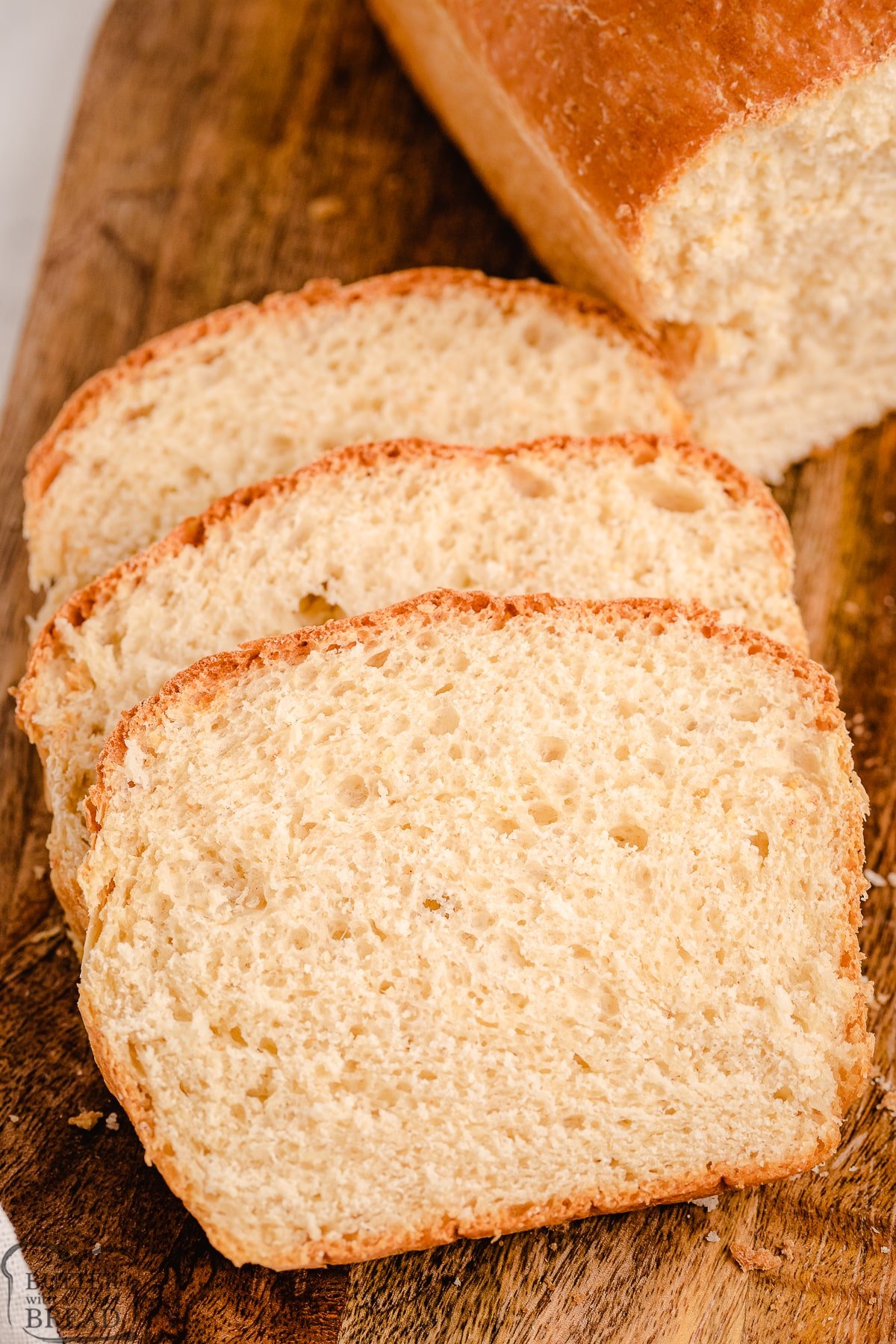
BEST BREAD PAN?
I bake a lot of bread and the pans I prefer are either ceramic, glass or cast iron. These pans will bake bread more evenly and release the bread more easily after baking. I don’t like using dark or nonstick pans because the bread cooks unevenly. It darkens on the outside before the bread is cooked on the inside, so the coloring is uneven. Read more about which bread pan is the best here!
How can you tell if bread is fully baked?
I like to use a food thermometer. Mine is digital, so it’s very easy to use. Fully cooked bread will be 190-200 degrees F. Since this bread contains a lot of milk, I don’t take it out of the oven until it reaches 200 degrees F. The top will be golden brown.
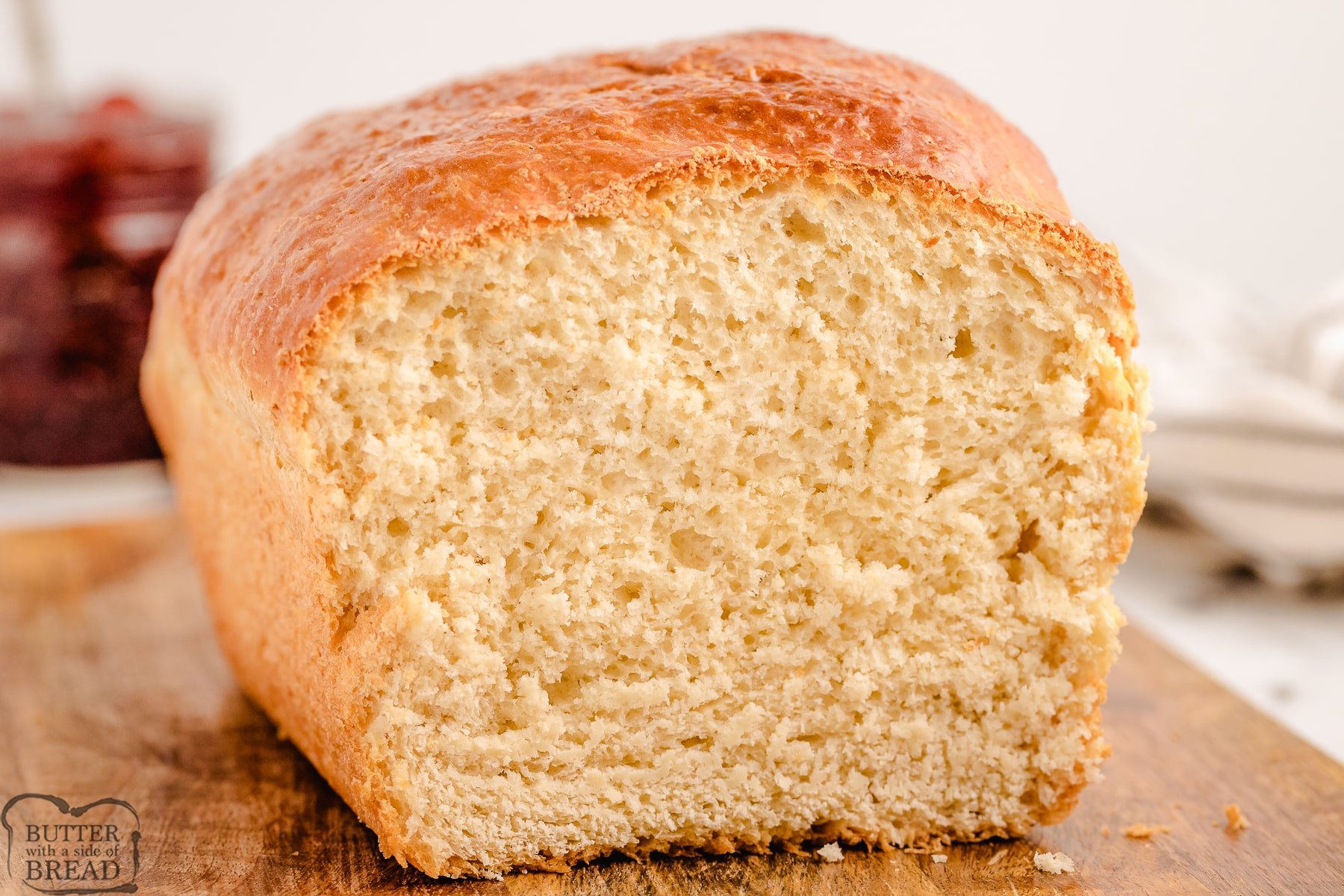
Here are even more recipes for homemade bread to try:
- Honey Wheat Bread
- How to Make Bread
- Homemade Hawaiian Bread
- Honey Oat Bread recipe
- Cinnamon Raisin Bread
- Parmesan Garlic Dinner Rolls
- Fabulous French Bread
- Sweet Orange Dinner Rolls
- Homemade Hawaiian Bread
- Easy Homemade Cheesy Breadsticks
- Tomato Parmesan Flatbread
- Potato Bread Recipe
- Soft Cornmeal Dinner Rolls
- White Bread Recipe
Homemade Buttermilk Bread can now be baked easily and fresh from the comfort of your own kitchen! This buttermilk bread recipe creates a lovely delicate loaf that has wonderful flavor and can be made in your bread machine.
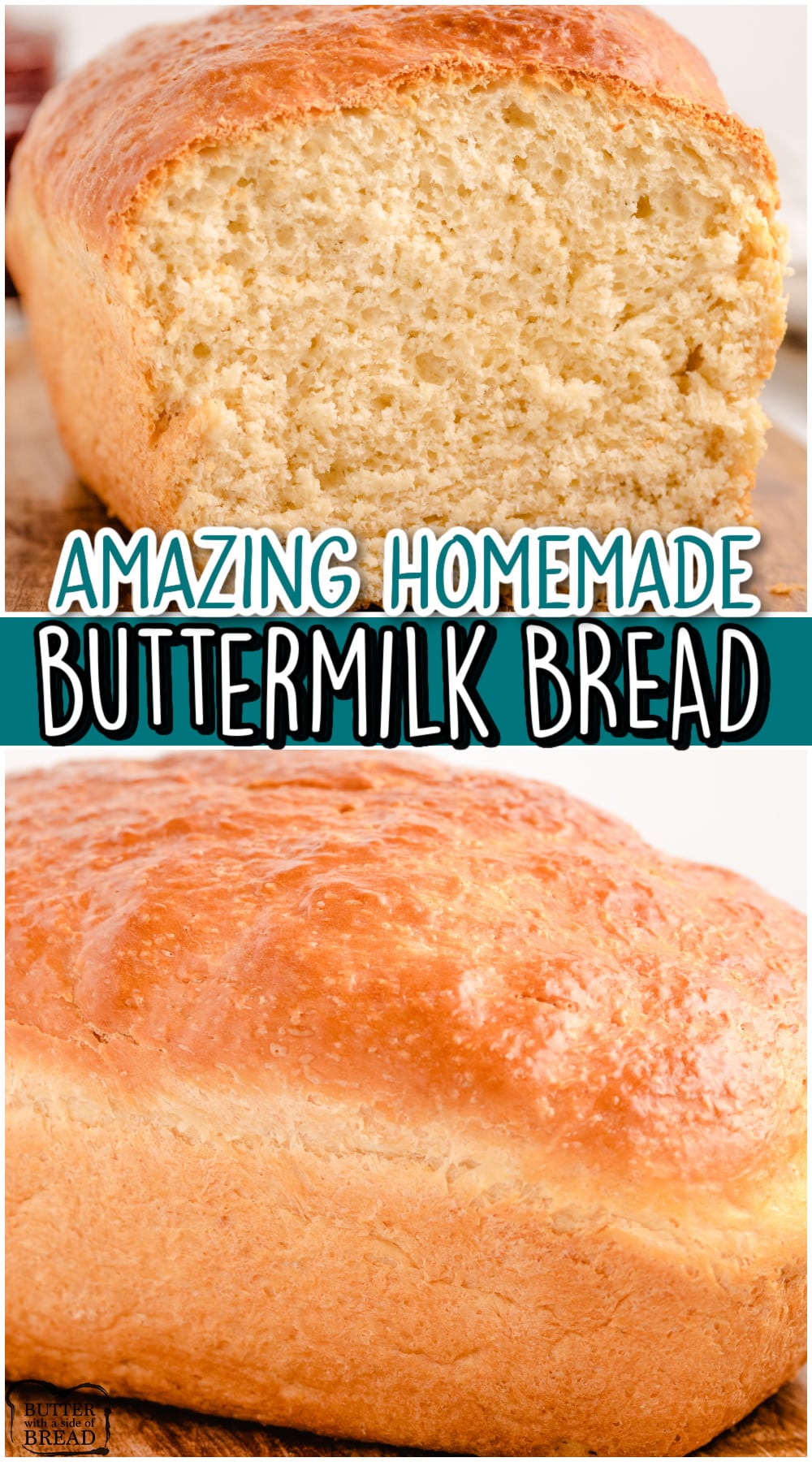


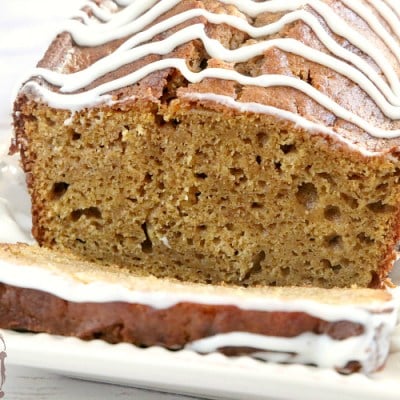
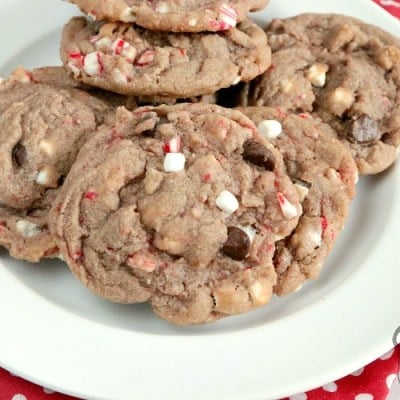
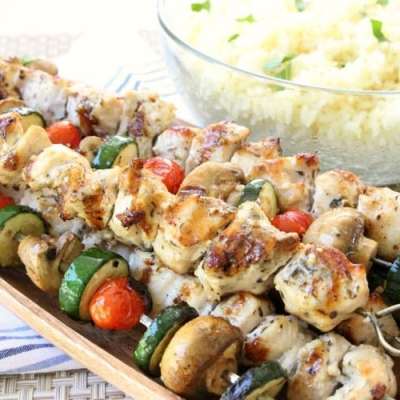
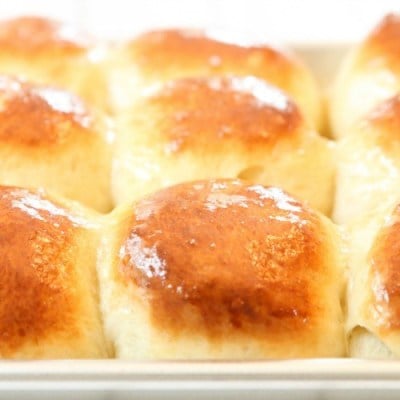
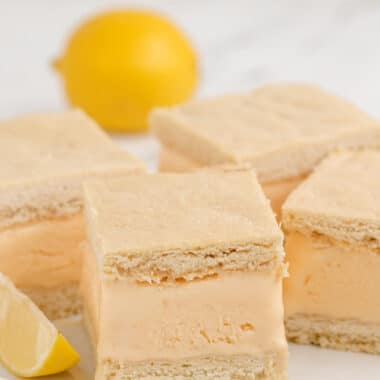
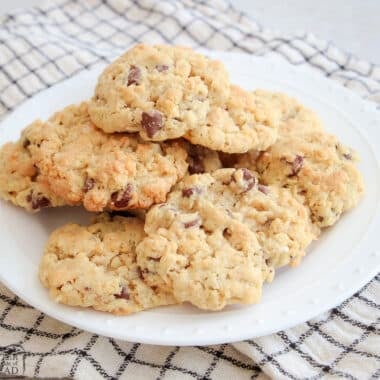


Christine R says
I just finished making another five loaves. This has been my go to bread recipe for over a year now. I make all my own bread and like a denser bread than store bought. THIS IS PERFECT. I usually use one recipe and halve it into two smaller loaves to share with two neighbors. I use a large microwavable mug and combine the buttermilk, cold butter and sugar then microwave for one minute and 45 seconds. Heats it to 100-110°F in my microwave. Sometimes I add a cup of shredded American cheese in the last two minutes of mixing in my stand mixer. Thanks again for sharing.
Nellie says
Thanks for sharing all of your suggestions…I love the idea of adding cheese!
Jacqueline Carrano says
Hi, will one packet be enough to make this bread? The packets are under a tablespoon but it’s all I have. Thanks
Jessica says
Yes you can make it with 1 packet of yeast. You might have to let it rise longer both times though!
Linda Gibson says
I made this bread tonight and it is delicious. Does this bread freeze well?
Rahel Haile says
Great recipe ! I had a lot of fun baking with your recipe.
Thank you.
Emmanuel Lai Adetoyi says
I thank you so much for your help.
Kindly give your expertise guidance on how to make home made bread for family consumption. Let me know the recipes list and how to perfectly make it. Thanks and God bless you 🙏
Chris says
Have tried many buttermilk bread recipes in the past…This is now my go to recipe. Easiest and best recipe I’ve ever used. I’ve worn out five bread machines so I use a large stand mixer now. There are only two tweaks I made to the recipe (my personal preference). I warm the buttermilk (Mom always warmed the liquid when making bread) to 120 degrees F and added the combined dry yeast and sugar to that and let it proof for a minute or two.
Mattie Gale says
Is there a difference in the consistency of the oven baked bread and bread baked in a bread machine?
Jessica says
Hmmm…I think the crust is a different consistency and I prefer oven baked over machine baked. The inside of the bread is very similar, as is the taste. Machine baked bread has a thicker crust that’s crisper…not sure that’s the right word to describe it! Drier? Oven baked bread has a thinner crust that softens after a few hours. Hope this helps!
Mattie says
I use powdered buttermilk and add it to the flour dry. I warm the water, dissolve the sugar in the warm water, add and proof the yeast, then add the powdered buttermilk to the salt and flour. I melt the butter and add it to the wet ingredients before adding the dry ingredients. It works well, no need to reconstitute, although you can if you wish. Be sure not to add the melted butter when it is too hot or it will kill the yeast.
RSue says
How much buttermilk powder do you use?
Tramyna Harris says
I didn’t want to waste the buttermilk I bought to just use a couple tablespoons out of. I was looking for buttermilk recipes to make and across this buttermilk bread recipe. Made this recipe and added a tablespoon of honey. Then I split it into two loaves. My two boys ( 7 & 13) ate it all it one day and asked me to make it again today! So we will be making it again.
David says
If you use buttermilk powder how much do you use for this recipe if you don’t reconstitute it?